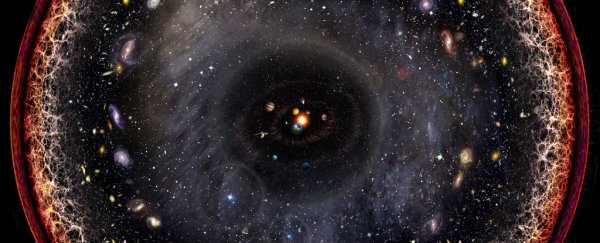For the first time in over a decade, scientists have updated our measurements of the radius of the observable Universe, and it turns out, it's not as big as we thought.
In fact, the part of the Universe that's technically visible from Earth right now just shrunk by about 320 million light-years in all directions, so come in closer, everyone, make some room.
Physicists Paul Halpern and Nick Tomasello from the University of the Sciences in Philadelphia have used new data on the Universe's expansion collected by the European Space Agency's (ESA) Planck satellite, and found that the observable edge of the Universe is actually 0.7 percent smaller than we thought.
They say that by using more accurate measurements, they've taken the radius of the observable universe from 45.66 billion light-years across to 45.34 billion light-years (1 light-year is about 9.5 trillion km, or 5.89 trillion miles).
"A difference of 320 million light-years might be peanuts on the cosmic scale, but it does make our knowable universe a little bit cozier," Tomasello writes over at Medium.
The observable Universe describes the concept that there's a certain number of galaxies and other matter that can, in theory, be observed from Earth at this very moment, because the light they emit has had enough time to reach us since the birth of the Universe some 13.7 billion years ago.
Physicists once thought that because we know roughly when the Universe began, and that light particles have to travel at a strict speed limit - the speed of light - we can say that there's a limit to the amount of distance a particle of light could have covered over the lifespan of the Universe.
This limit is called the particle horizon, and it's how we define the boundaries - or edge - of the observable Universe.
But there's a big problem here - the size of the Universe isn't static. It's expanding, and by a recent measure published earlier this year, it might be expanding faster than our laws of physics can explain.
So how do you figure out the maximum amount of distance a light particle can travel in something that keeps getting bigger?
Back in 2003, a team led by physicist J. Richard Gott from Princeton University figured out how to come up with a more accurate measure of the observable Universe.
They took an event called recombination - which occurred about 378,000 years after the Big Bang, when the Universe had cooled enough to allow electrons and protons to bond together into hydrogen atoms - and combined it with the rate of the Universe's expansion and certain other variables in an incredibly complex equation, and came up with a radius of 45.66 billion light-years.
A big part of figuring all this out was using data from the now-retired WMAP satellite to map the afterglow of the Big Bang, but as Tomasello explains, we've since got more advanced technology to collect that information.
"Operating from 2009 to 2013, the Planck satellite scanned the surrounding expanse of space and provided more up-to-date figures about the expansion rate and other parameters of our Universe," he says.
When they applied the Planck data to a calculation of the radius of the particle horizon, they ended up with a distance of about 45.34 billion light-years.
"Therefore, the range of what we can see is actually 0.7 percent smaller than once thought," says Tomasello. "In terms of the distances we're dealing with, it's not a huge amount, but sometimes science has to take small steps."
The study has been accepted for publication in an upcoming edition of Advances in Astrophysics, but in the meantime, you can read more of Tomasello's take here.
